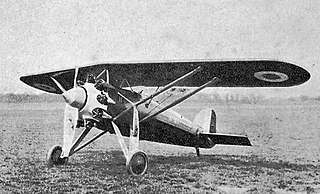Related Research Articles

The WZ.X was the Polish reconnaissance aircraft designed in the mid-1920s and manufactured in the Centralne Warsztaty Lotnicze (CWL) - Central Aviation Workshops in Warsaw. It was the first combat aircraft of own design built in Poland, in a small series.

The Vickers F.B.19 was a British single-seat fighting scout of the First World War, developed from the Barnwell Bullet prototype, and sometimes known as the Vickers Bullet. It served with the Royal Flying Corps and the Imperial Russian Air Service, which subsequently led to the Red Air Force adopting it during the Russian Civil War.

The Morane-Saulnier M.S.225 was a French fighter aircraft of the 1930s. It was produced in limited quantities to be used as a transitional aircraft between the last of the biplanes and the first monoplane fighters.

The Bleriot-SPAD S.51 was a French fighter aircraft developed in 1924 in response to a French Air Force requirement for an aircraft to replace their obsolete Nieuport-Delage NiD.29s.
The Blériot-SPAD S.81 was a French fighter aircraft developed in 1923 to a requirement by the French Air Force. It was flown competitively against the Dewoitine D.1 and was selected over that aircraft due to the Dewoitine's more radical design, leading to an order for 80 aircraft. The S.81 was a single-bay biplane of conventional configuration with I-shaped interplane struts and lacking Herbemont's usual swept upper wing. It featured a wooden fuselage of monocoque construction and metal wings skinned in fabric. Production versions differed from the prototypes in having a lengthened fuselage and larger tail fin.

The Morane-Borel monoplane was an early French single-engine, single-seat aircraft. It was flown in several European air races.
The Pemberton-Billing P.B.25 was a First World War British single-seat scout aircraft built by Pemberton-Billing Limited, later Supermarine Aviation Works Limited.

The Morane-Saulnier AI was a French parasol-wing fighter aircraft produced by Morane-Saulnier during World War I.
The Morane-Saulnier AF, also known as the Morane-Saulnier Type AF and the MoS 28 was a French First World War single-seat biplane fighter prototype from 1917.

The Morane-Saulnier AN or MoS.31 C.2 was a French two seat fighter prototype of the 1910s that resulted in the development of several other unsuccessful Morane-Saulnier prototypes.
The Sopwith 8F.1 Snail was a prototype British Fighter aircraft of the First World War. It was unsuccessful, being abandoned due to an unreliable engine.

The Vickers E.S.1 was an early British Fighter aircraft of the First World War. A single-seat biplane, only three E.S.1s were built, although at least one was used by a home defence squadron of the Royal Flying Corps.

The Wibault 10/II Tramontane was a two-seat reconnaissance aircraft designed and built by Société des Avions Michel Wibault in France for the French military 1923 A.2 competition for a 2-seater reconnaissance aircraft.

The Blériot-SPAD S.91 was a French light-weight fighter aircraft. It would be later developed into the Blériot-SPAD S.510, the last biplane produced by the French aeronautic industries.
The Caudron C.220 was a two-seat French biplane trainer. Only two were built, using different engines.

In October 1917 Nieuport began construction of a prototype monoplane fighter known as the Nieuport Madon, a strut braced monoplane.

The Sikorsky S-9Kruglyj was a Russian single engine prototype aircraft completed in the spring of 1913 by the Russian Baltic Railroad Car Works while Igor Sikorsky was the chief engineer of the aircraft manufacturing division.
The Morane-Saulnier MS.152 was a French multi-purpose aircraft built in 1928. It did not go into production.

The Morane-Saulnier MS.221 was a French fighter aircraft, built in 1928 to compete for a government contract in the "Jockey" programme. Two were built, one of which was progressively modified to increase its speed, but in 1930 the light fighter concept was abandoned.

The Morane-Saulnier MS.224 was a prototype fighter plane built by Morane-Saulnier in the early 1930s.